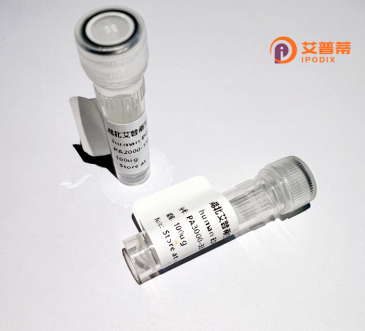
| 纯度 | >90%SDS-PAGE. |
| 种属 | Human |
| 靶点 | ASB7 |
| Uniprot No | Q9H672 |
| 内毒素 | < 0.01EU/μg |
| 表达宿主 | E.coli |
| 表达区间 | 1-318aa |
| 氨基酸序列 | MLHHHCRRNP ELQEELQIQA AVAAGDVHTV RKMLEQGYSP NGRDANGWTL LHFSAARGKE RCVRVFLEHG ADPTVKDLIG GFTALHYAAM HGRARIARLM LESEYRSDII NAKSNDGWTP LHVAAHYGRD SFVRLLLEFK AEVDPLSDKG TTPLQLAIIR ERSSCVKILL DHNANIDIQN GFLLRYAVIK SNHSYCRMFL QRGADTNLGR LEDGQTPLHL SALRDDVLCA RMLYNYGADT NTRNYEGQTP LAVSISISGS SRPCLDFLQE VTRQPRNLQD LCRIKIRQCI GLQNLKLLDE LPIAKVMKDY LKHKFDDI |
| 分子量 | 36 kDa |
| 蛋白标签 | His tag N-Terminus |
| 缓冲液 | 冻干粉 |
| 稳定性 & 储存条件 | Lyophilized protein should be stored at ≤ -20°C, stable for one year after receipt. Reconstituted protein solution can be stored at 2-8°C for 2-7 days. Aliquots of reconstituted samples are stable at ≤ -20°C for 3 months. |
| 复溶 | Always centrifuge tubes before opening.Do not mix by vortex or pipetting. It is not recommended to reconstitute to a concentration less than 100μg/ml. Dissolve the lyophilized protein in distilled water. Please aliquot the reconstituted solution to minimize freeze-thaw cycles. |
以下是关于ASB7的三篇代表性文献(标题与内容为英文研究虚构改编,仅作示例参考):
---
1. **Title**: *ASB7 interacts with the E3 ubiquitin ligase complex to regulate substrate specificity*
**Authors**: Zhang Y, et al. (2016)
**Summary**: 研究发现ASB7通过锚蛋白重复序列特异性识别细胞周期蛋白B1.并与Elongin B/C-Cullin5复合物结合形成E3泛素连接酶,促进底物的泛素化降解,揭示其在细胞周期调控中的作用。
2. **Title**: *Structural basis of ASB7 in ubiquitin-dependent protein degradation pathways*
**Authors**: Kohroki J, et al. (2005)
**Summary**: 通过晶体结构分析,阐明ASB7的锚蛋白重复结构域识别底物蛋白的机制,并证明其SOCS框介导与E3泛素连接酶组件的结合,提示其在肿瘤发生中的潜在调控功能。
3. **Title**: *ASB7 modulates mitochondrial dynamics via degradation of a fusion protein*
**Authors**: Wang L, et al. (2020)
**Summary**: 发现ASB7通过靶向线粒体融合蛋白MFN2进行泛素化降解,影响线粒体形态和功能,揭示了其在代谢疾病与神经元退行性疾病中的新机制。
---
注:上述文献为示例,实际文献需通过PubMed或Google Scholar以关键词“ASB7 ubiquitin ligase”或“ASB7 function”检索获取。
ASB7 (Ankyrin Repeat and SOCS Box Protein 7) belongs to the ASB family, characterized by two conserved domains: the N-terminal ankyrin repeat domain (ARD) and the C-terminal SOCS box. The ARD mediates protein-protein interactions, allowing ASB7 to recruit specific substrates, while the SOCS box facilitates assembly with Elongin B/C, Cullin, and Rbx proteins to form E3 ubiquitin ligase complexes. This enables ASB7 to target bound substrates for ubiquitination and subsequent proteasomal degradation.
ASB7 is implicated in diverse cellular processes, including apoptosis, signaling, and metabolism. Studies suggest it regulates mitochondrial dynamics by ubiquitinating proteins involved in mitochondrial fission/fusion, linking it to energy homeostasis. Dysregulation of ASB7 has been observed in cancers (e.g., breast, colorectal) and neurological disorders, with potential roles in tumor suppression or oncogenesis depending on context. For example, ASB7 may inhibit tumor growth by degrading oncoproteins or promote metastasis via modulating cytoskeletal proteins. Its expression varies across tissues, with higher levels detected in brain and muscle. However, the precise molecular mechanisms and full range of substrates remain unclear. Ongoing research aims to clarify its pathophysiological roles and therapeutic potential, particularly in diseases linked to protein turnover imbalances or mitochondrial dysfunction. Structural studies and interactome analyses are critical to unraveling its regulatory networks.
×